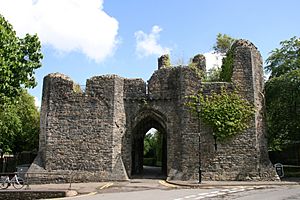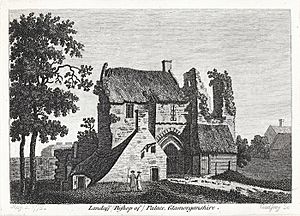Bishop's Palace, Llandaff facts for kids
Imagine a grand old building where important bishops once lived! That's the Bishop's Palace, Llandaff, also called Llandaff Castle. It's now mostly ruins, but you can still see parts of it. This historic place is found near the Llandaff Cathedral in Cardiff, Wales. The most impressive part still standing is its gatehouse, which has two towers.
History of the Palace
The gatehouse you see today looks a lot like parts of Caerphilly Castle. This might mean the same skilled builder, called a master mason, helped design both places! If so, the Palace was likely built around the time William de Braose became the Bishop of Llandaff in 1266.
People believe the Palace was attacked and damaged during a big rebellion led by Owain Glyndŵr between 1402 and 1405. After this, the bishop living there moved away to Mathern Palace. Bishops didn't live near the Llandaff Cathedral again until 1850.
The Palace was still standing in 1610, as shown on an old map by John Speed. However, it was probably destroyed later during the English Civil War. This was a time of great conflict in England, Scotland, and Wales.
What the Palace Looked Like
The Bishop's Palace was actually a small fortress from the Middle Ages. It was built inside a rectangular area about 52 meters (170 feet) long and 40 meters (130 feet) wide. It had four walls of different lengths, three towers, and a gatehouse at one corner.
One tower was square, and another was round. The third tower has completely disappeared over time. The gatehouse, which still stands, has two towers. It originally had two floors above a basement. It also had a strong arched entrance, a slot for a heavy metal gate called a portcullis, and a large oak door with fancy ironwork.
Inside the courtyard, there would have been wooden buildings. However, there are no signs of these buildings left today. The remains of the Bishop's Palace are considered "Grade I listed." This means they are very important because of their amazing architecture and long history.



